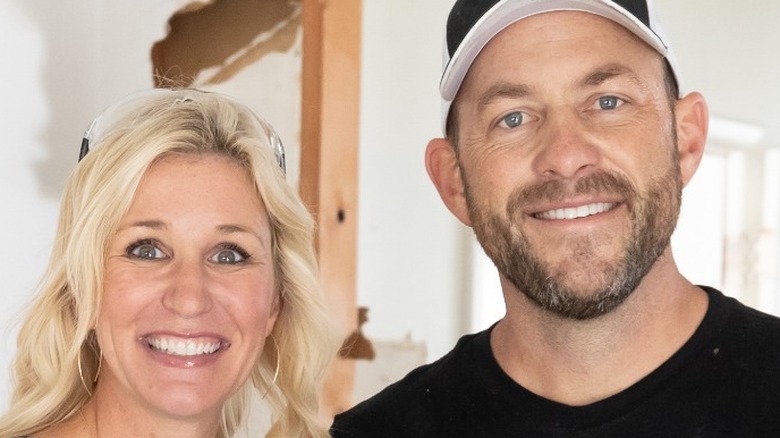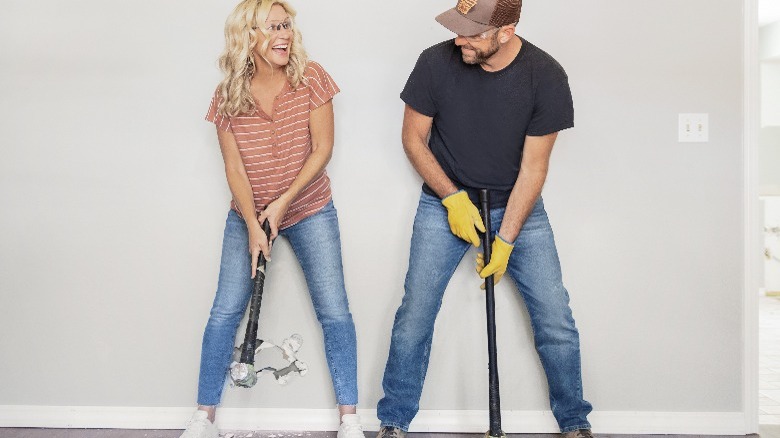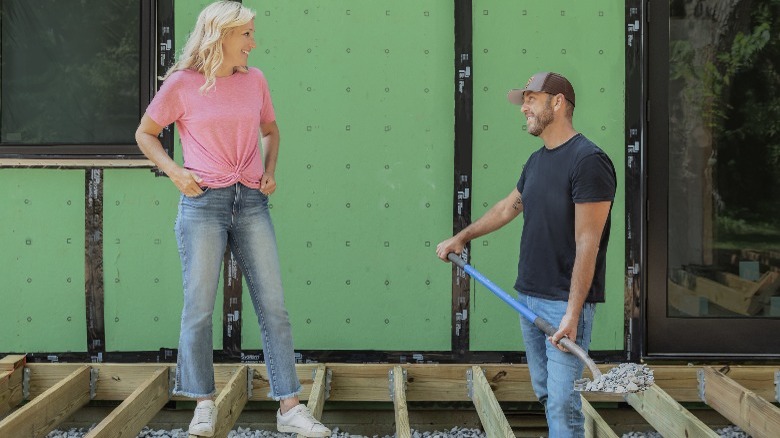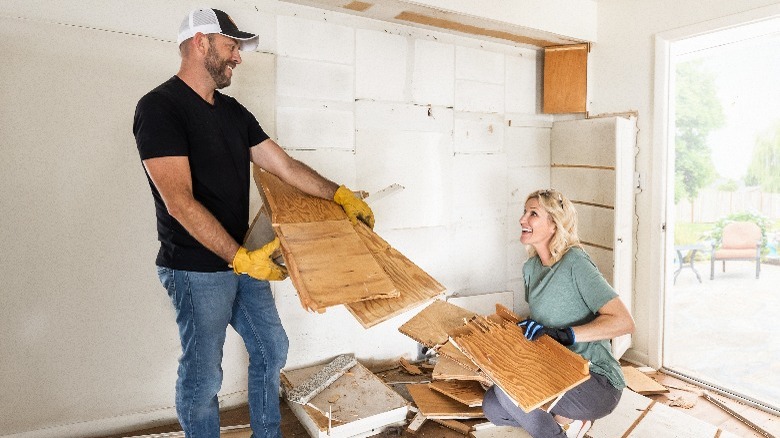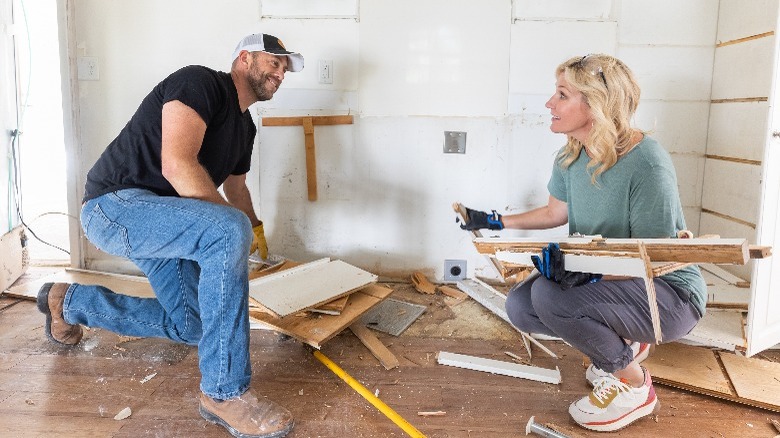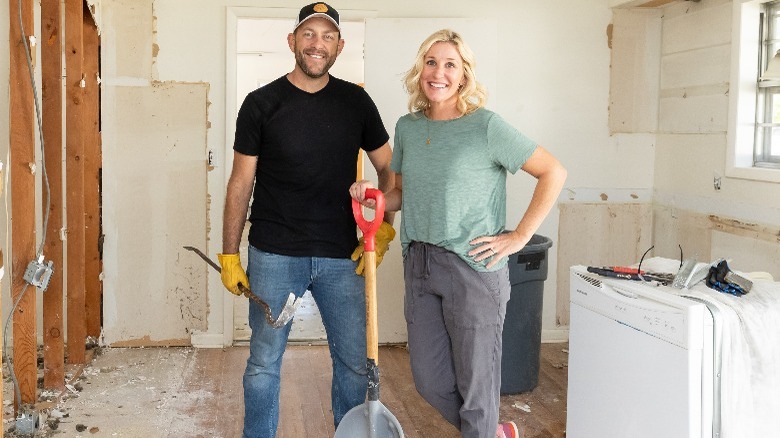HGTV's Dave And Jenny Marrs Discuss Restoring Historical Homes - Exclusive Interview
The draw of a brand-new home may be enticing to some, but it's the character of historical homes that gets Jenny and Dave Marrs excited. Their family farm, which they restored for themselves and their five children, is the perfect example of their design philosophy of creating spaces that are not only beautiful but also functional for the family that lives there.
The two are experts in renovation and design and use their talents to transform the homes in Bentonville, Arkansas, which they call home. On HGTV's "Fixer to Fabulous," the Marrses work with families to create customized spaces. As Dave tackles the construction, Jenny personalizes the home's interior. The Marrses' passion shows through the custom-designed homes they create for each of their clients.
Dave and Jenny Marrs sat down for an exclusive interview with House Digest to discuss renovating and restoring historical homes throughout Northwest Arkansas, providing tips and advice that anyone can use to create their dream home.
Their restoration projects are personal
The two of you live on a farm that you restored. Can you tell me a little bit about the process of restoring it?
Dave Marrs: We bought this old farm property probably about 12 years ago, 13 years ago, and we got a house that was going to be torn down in the downtown area of our small town in Arkansas. We live in Bentonville. We bought the house, which we lived at out here, and completely redid it, and then we bought our farm that had been unused since it had been completed 100 years ago, and we turned it back into a working farm. So we've got a blueberry farm; we got apple, peaches, pears, blackberries.
The process of restoring it back to what it was is an ongoing process that will probably never end, but we're taking it one day at a time, and the maintenance is keeping up with it while our kids are being raised. Now we have cattle, a sheep, an alpaca, chickens, rabbits, dogs, and cats. ...
What was your favorite project from this upcoming season, and is there one that you're really excited for fans to see?
Jenny Marrs: My favorite upcoming project — that's a tough one. They're all unique. One of my favorites is the log cabin that we did. It was beautiful and unique. It's a really pretty property.
We also restored an old building that we are transforming into a mercantile. There will be tons of products, everything that we love. Local artisans and makers, artists, and all of our favorite products will be in the store.
We have a place here in Northwest Arkansas where fans can buy our favorite things. We were able to restore the actual building that is from 1905 and make it into this incredible space. It used to be a bank, so we had to give a nod to the original bank. We have a vault door that leads to the bathroom. We have some really cool tile that is [a] tribute to the original building. That's a really fun project that's taken up a [lot] of the year as well.
When can fans expect to visit that?
Jenny: We open in April.
Dave: We'll finish it next month, but then we won't open it until this episode airs.
Historical homes are built to last
When you plan to restore [a] historic[al] home, what are some signs that it has good bones? Are there any structural details of a home that impact your design decisions?
Dave: As far as good bones, pretty much all older homes have good bones. They were built, a lot of them, with hardwood like oak, so they stand the test of time even more so than homes that are built today. Structurally, yes, you do get into some structural issues, and it's important we're upfront about where the load-bearing walls are, where we can add and take walls out ... That's all stuff that we go over with the homeowner before we get into the project.
Are there any specific structural details that you look for or that you know will give you trouble?
Dave: Yeah. I've been building here for 20 years, so you know if you have cracked foundations that are settling at different points, where one side of the house is moving and the other isn't, that's a big red flag. If you look up at the top of the roof and it looks like an old horse, where it's got the bowed back, that's usually a very good sign that you got some serious settling in the middle. [With] a lot of these old homes, they did a really good job on the exterior foundation, but they didn't focus a lot inside. They bow in the middle. When we go into them, we know these are some of the issues that we're going to run into.
A lot of times, we can run a steel beam across the crawlspace or the lower part of the foundation to level it all out before we then go and fix anything above. But those are the red flags that we look for when we're casting, and [we] make sure that the homeowners are aware and that we can fix them within the timeframe we have.
What are some features of historic[al] homes that get you excited when you see them?
Jenny: Just the character of the home. I think any old house has a lot of character that's inherent to the home based on the time that it was built. We love all of the details, the millwork, the unique angles, the original floors, what's hidden behind the walls. All of that good stuff is what we love and try to preserve.
Dave: [With] a lot of these old homes, what is so iconic about them are the details that they put on the outside of the house, which you don't see as much anymore. Your houses are ... You've got all the brick; you've got all the right things on the outside, but there's attention to details on the inside. There is attention to detail, like the trim and the corbels and different things, that make these old homes so unique.
Renovation requires flexibility
What is one of the most challenging aspects of restoration that newcomers might not think of? Are there any mistakes that they frequently make in restoration?
Dave: Always plan on it taking longer and costing more. When you get into these, you never know what you're going to get into, and I've been doing this for 20 years. We've gotten pretty good about [renovating] homes, but it never fails: There's always a surprise. I always tell people, "If this restoration takes an extra month or an extra two months, this is something that you're trying to put together for your family for a lifetime, so take the time. If there's something that you really want that's going to take an extra month to get in, let it take an extra month. In the whole scheme of things, [to finish] this house how you want, you shouldn't really have that strict timeframe on it."
Looking back on your past renovations, are there any choices that you would change based on the design outcome?
Jenny: What's exciting about renovation is [you have to] have an open [mind because] things aren't going to go as planned; they never do. Always having the ability to commit is the biggest thing that makes a successful renovation. There's been lots of times that we've had one plan going into a project, and then had to change that because of many different reasons, whether it's structural or we don't get product in time or product arrives broken.
There's so many scenarios that have happened over the years, but always feeling like we can figure it out and come up with a new plan has been how we approach a project. I wouldn't necessarily say that we would go back and change anything because I think they're all [projects] we can be proud of.
Dave: Right, and we're working it in our projects and in the projects that we do for the show. We're trying to make a reflection of the family that lives there. That's the thing. People so many times are wanting to make a picture, make it this perfect space that doesn't really fit their family. It's your house. Make it a reflection of how you want to live and how you want the space to function.
Personalization is key in renovations
How would you suggest that families go about making a space that fits them and their needs and their lifestyle?
Jenny: It's all about figuring out how you need to use the space [and] considering different ways of using spaces. A lot of times, people buy a house and they think, "This is the dining room. This is the living room. That's how I have to keep it," but you don't. You can mix it up and figure out what you need. Do you need a dining room, or do you need a bigger dining room? You can figure out how you will use the space and then go from there with what works for you and not worry about what other people think or what other people have done in the past with the space.
Always personalize the spaces to fit your needs and your family, to tell your story, whether it's photos or framing important pieces of memorabilia, or making wallpaper out of art. Figure out ways to personalize the space [so] that it reflects who you are and [the] things that you love. If it makes you happy, then that's all that matters because you're the one that has to live there. Not getting caught up in trends and worrying about what other people think is the most important thing.
Speaking of trends, are there any design trends that you hope will catch on, that you think will be good for people to try?
Jenny: Again, if it's whatever you like ... [For example], if you really love the color orange, paint the kitchen orange. It's your kitchen. Don't get scared of feeling like, "I can't do that because it's not a trend." It's a matter of what makes you happy. It's your space; you're the one that has to live there.
You can always paint. Paint is an easy way to start. You can always repaint the space if you don't like it. It's inexpensive. It takes time but isn't expensive, and it's something that can be changed fairly easily. If you're trying to take a risk and do something bold, paint's probably the easiest and the favorite way to start.
Knowing how to work together is essential
How do you balance your design ideas when you're working on a project together?
Dave: Jenny and I start with [asking], "Structurally, what can we do? Can we open up all these walls? Can we physically do that?" We start with, "This is the homeowner's want. This is structurally what we can do." Then from there, it's taking their wants and making them a reality where we can do so without damaging the integrity of the house. Jenny and I go back and forth, where we want to bring the wall all the way up to the ceiling, but we can't because we have to put a header in there for support loads. We work very well within that. The safety of the home is first and foremost, and then after that, design takes place on the needs of the family.
How would you suggest that couples collaborate to work [on] their home design?
Dave: I think the most important thing that a lot of couples don't do [is] hire an architect, someone that comes to the house ... that can look at it and go, "Here's where you can open up walls. Here's where you can structurally do things," because it's so much cheaper to do all of this on paper before you start tearing out walls. So many people get excited about the remodel, start the demo process, and then realize, "Shoot, we can't even take that wall out." Then you're doing a lot of double work, versus spend[ing] the time upfront. There are programs now, like our architect['s], [where] you can literally put on a pair of goggles and three-dimensionally walk through the space that he's drawn for you on your house. That's a good way to realize if it's something you're going to want.
The new season of "Fixer to Fabulous" premieres November 29 at 9 p.m. ET/PT on HGTV and discovery+.
This interview has been edited for clarity.
